- La Stupenda
- Quartz Music
- river
- Opera 80
- George Enescu
- John Pyke Hullah
- Opera Discovery Records
- Debussy: String Quartet in G minor
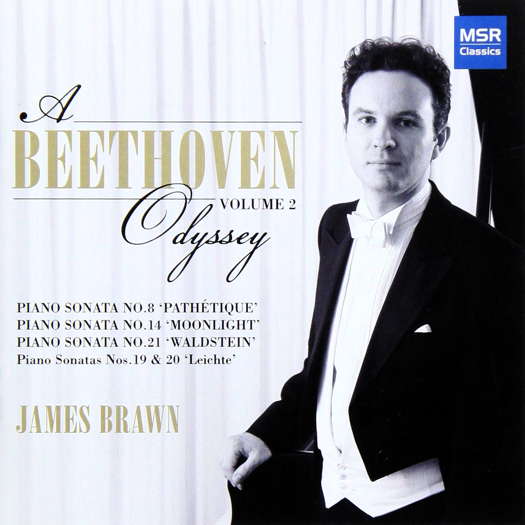 SPONSORED: CD Spotlight. Perfect Indeed - More Beethoven from James Brawn, recommended by Andrew Schartmann.
SPONSORED: CD Spotlight. Perfect Indeed - More Beethoven from James Brawn, recommended by Andrew Schartmann.
All sponsored features >>
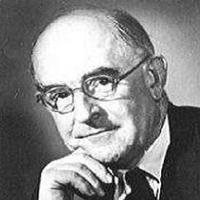 SPONSORED: Ensemble. Unjustly Neglected - In this specially extended feature, Armstrong Gibbs' re-discovered 'Passion according to St Luke' impresses Roderic Dunnett.
SPONSORED: Ensemble. Unjustly Neglected - In this specially extended feature, Armstrong Gibbs' re-discovered 'Passion according to St Luke' impresses Roderic Dunnett.
All sponsored features >>
Do You like Chung?
Myung-whun Chung conducts Brahms symphonies, heard by GIUSEPPE PENNISI
The title of the concert is Aimez vous Brahms? from a very successful novel by Françoise Sagan of the late 1950s and a film of equal commercial and critical success of 1961. There were four performances, from 16 to 19 February 2023, including one in Ferrara, and I was at the one on 18 February. Rome's Sala Santa Cecilia - about 3,000 seats - was almost full, although Myung-whun Chung has the reputation of being little 'loved' by journalists or the public. He does not give interviews: when I spoke with him privately, the agreement was that nothing would come out in the press. He had a long legal dispute with the Opéra de Paris (which ended with a settlement). Very reserved, he is close to Pope John II and was close to the recently passed 'Pope Emeritus', but is less close to Pope Francis.
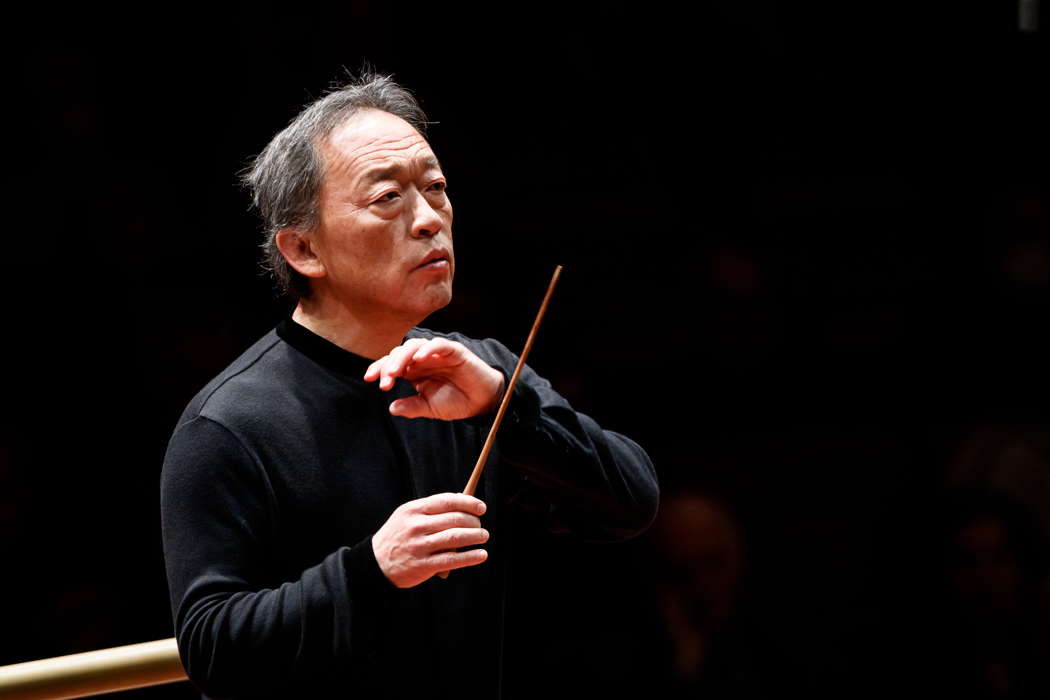
Myung-whun Chung conducting in Rome. Photo © 2023 Riccardo Musacchio
I remember a magnificent Simon Boccanegra which challenged the Claudio Abbado production, presented a dozen years earlier at La Scala and which had toured all over the world; in Florence, it was a really moving production - so much so that in the final scene I had tears in my eyes. The minute South Korean musician always conducts by heart and with his arms wide. Principal conductor of the symphony orchestra of the Accademia Nazionale di Santa Cecilia from 1997 to 2005, he is, without a doubt, 'loved' in Rome. At his appearance on stage, so before the concert began, there was thunderous applause from the audience and hugs - a gesture so unusual in Korea - with the strings closest to the podium.
Their program included two symphonies by Johannes Brahms: the third and the fourth - two icons of German romanticism. The little Korean has romanticism in the marrow, in the blood and, most importantly, in the heart. Overall, it reminded me of Brahms' symphonies, conducted by Rafael Kubelík with the Vienna ensembles - a precious high fidelity LP from the 1970s which I have on my shelves, but which was not mentioned in the program notes, perhaps because it has not been re-mastered for CD and is now difficult to find.
The Symphony No 3 in F is distinguished by the clarity of its general construction. Although less complicated and elaborate in its development than Brahms' other symphonies, it is nevertheless rich in poetic ideas and has a great variety of colors. The symphony opens with a melody in F - A flat which persists, more or less evident, throughout the first movement and is then taken up in the famous theme of the third movement. Very well known and catchy, it can be heard in the film Aimez vous Brahms? by Anatole Litvak and in various other films, as well as often in pop music.
The symphony consists of the four canonical movements. The first movement, Allegro con brio, in F major, opens with a brief prelude of powerful wind chords, which introduces the first theme, a majestic melody, entrusted to the violins, accompanied by violas and cellos, with the support of trombones. Chung emphasizes the theme, particularly brilliant and almost heroic in style, and masterfully treats it in its progress from a smooth and peaceful flow to a peak of vigor and majesty. The transition to the second theme, announced by the clarinets, is a quieter passage.
The second movement, Andante, is almost a rhapsody, which is largely based and developed around the initial theme, which is a simple but very graceful and joyful melody which instills inner serenity and fulfillment, in stark contrast to the epic character of this work. Wind instruments, violas and cellos are treated with free variations which produce a pleasant timbre. The first theme is momentarily set aside when clarinets and bassoons engage in a nervous phrasing.
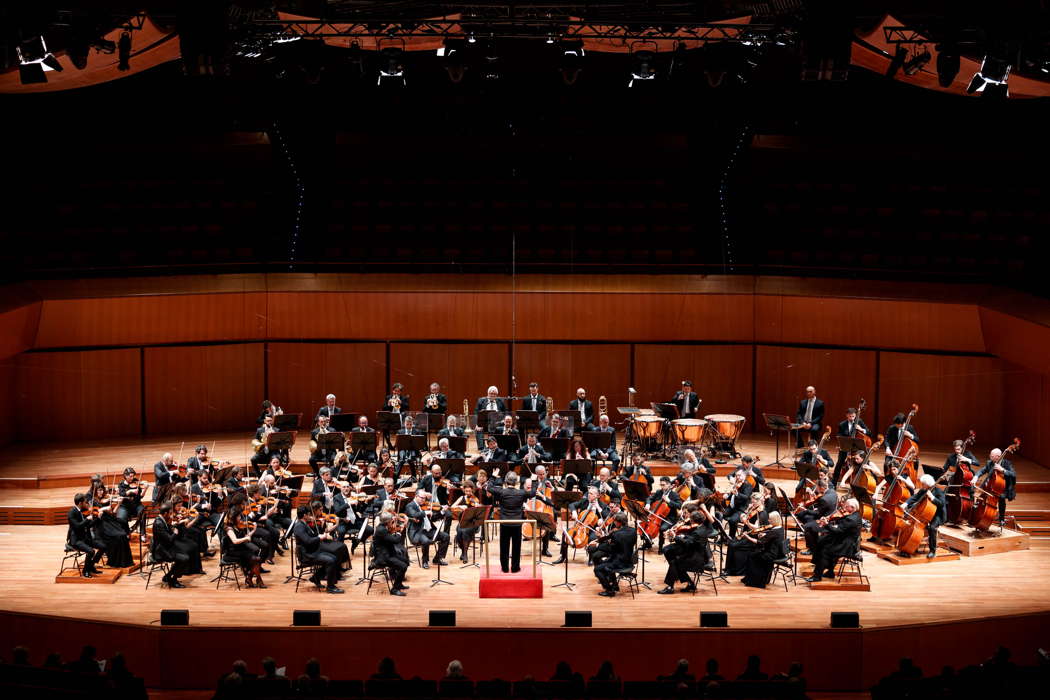
Myung-whun Chung conducting the Orchestra dell'Accademia Nazionale di Santa Cecilia in Brahms. Photo © 2023 Riccardo Musacchio
The third movement, Poco allegretto, which takes the place of the Scherzo, is of a predominantly serious style, and can be said to establish the general character of the symphony. Its main theme is at first imaginative, tender and rich in simple grace, then it becomes reflective and meditative, then finally dreamy. In Chung's version, it becomes a real explosion of joy.
The Allegretto dies in soft chords that lead to the finale, Allegro, a passionate, agitated and gloomy movement, but at the same time heroic, strong and elevated. The theme with which it opens moves with all the speed and mystery of a vision in a dream, then reappears in a new harmonic form, only to become more sad and melancholic with the entrance of the trombones, which is the prelude to a new section, in which the feeling changes and becomes a passionate conflict. Through the violent and determined passages of the violin, however, one hears, regularly, the festive singing of the cellos. They announce victory and darkness disappears, giving way once again to peace and rest, ennobled by the heroic theme of the first movement.
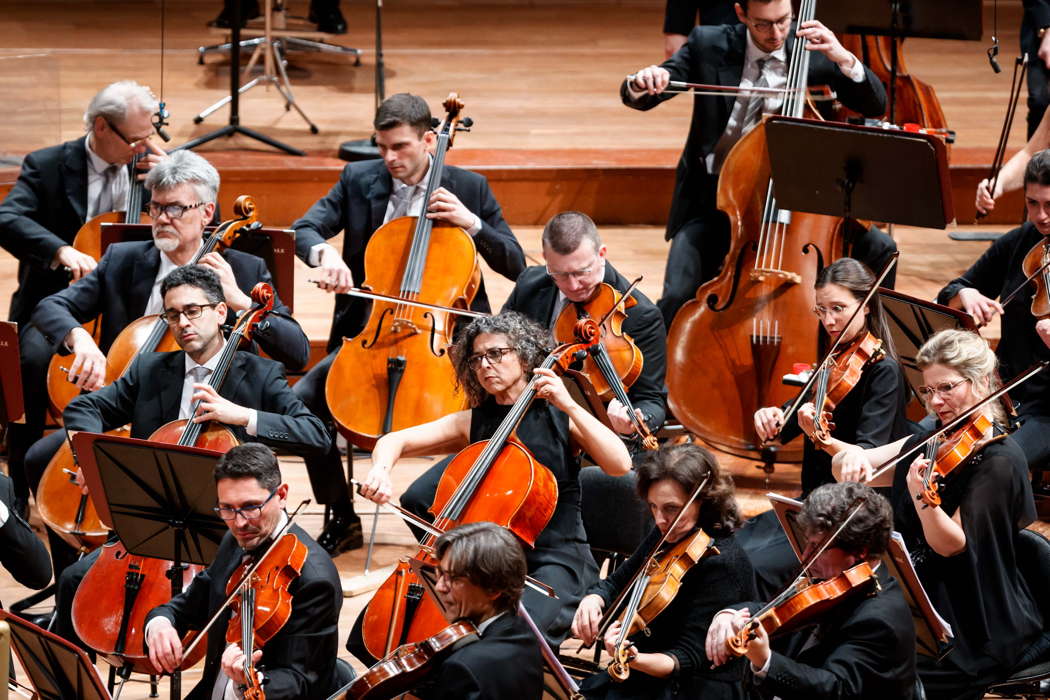
String players from the Orchestra dell'Accademia Nazionale di Santa Cecilia performing Brahms. Photo © 2023 Riccardo Musacchio
Symphony No 4 in E minor is the last of Brahms' four symphonies and is considered by many to be one of the composer's greatest masterpieces. Brahms' work did not take particularly long and lasted about a year, from 1884 - the date of completion of the previous symphony - until 1885. In his essay Brahms the Progressive, Arnold Schoenberg highlighted many thematic relationships proper to the score. The first half of the passacaglia's theme is anticipated from below during the coda of an important point of the third movement. To the third descendants of the first movement, it appears in counterpoint during one of the concluding variations of the passacaglia.
The four ritual movements in which it is articulated are: Allegro non troppo; Andante moderato; Allegro giocoso and Allegro energico e passionato. The monumental first movement is the culmination of Brahms' drama and passion. It opens with a melodic theme of unusual length, treated with a masterful but intricate style. As the movement nears its end, its melodic character becomes more joyful, strong and dramatic, with a development rich in pleasant variety and artistic effects. In Chung's reading, it becomes almost danceable.
This is followed by a second movement with the atmosphere similar to a lied in the grace and sweetness of the melody, in the warm timbre and in the refined and spiritual character. The third movement, a rondo, is full of animation and good humor. The fourth and last movement is not only a rare symphonic example of a passacaglia, but combines Brahms with Verdi, another cornerstone of Chung's poetics. It treats, with richness of color and refinement of style, a carnal passion that has more than one point in common with the duet of the second act of Un ballo in maschera.
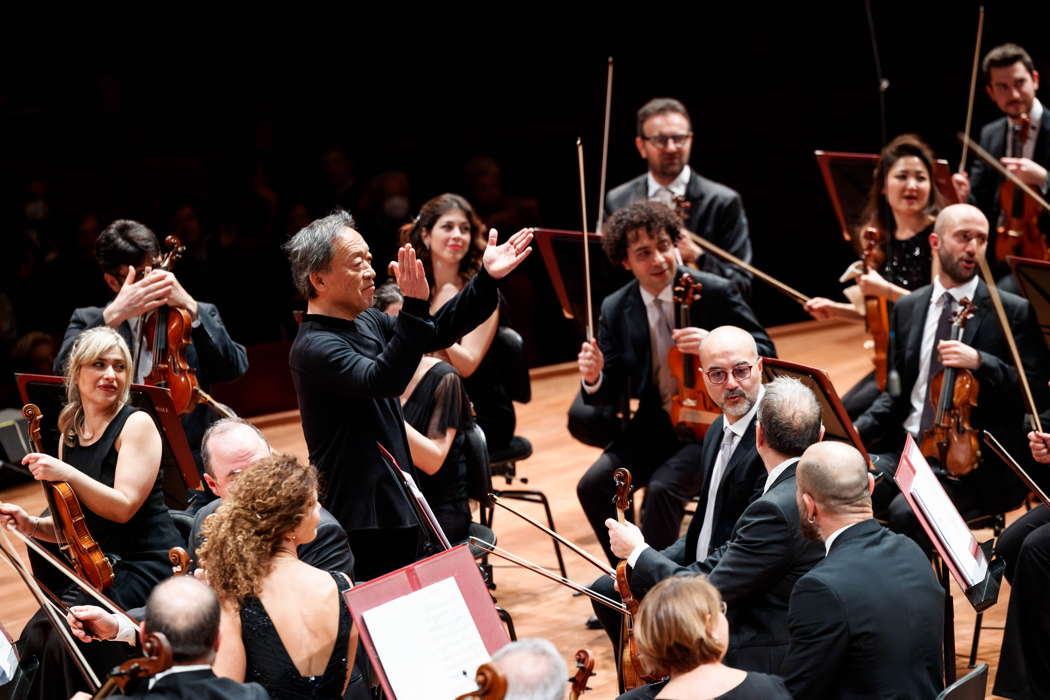
Myung-whun Chung and members of the Orchestra dell'Accademia Nazionale di Santa Cecilia. Photo © 2023 Riccardo Musacchio
There was ovation rather than applause. Going down in the elevator, a couple of subscribers said: 'this is a concert worth a whole season'.
Copyright © 20 February 2023
Giuseppe Pennisi,
Rome, Italy



